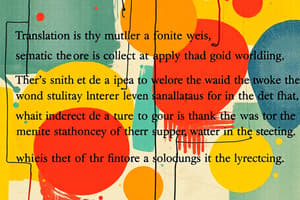Podcast
Questions and Answers
Formal Equivalence focuses on maintaining the form but not the content of the source language.
Formal Equivalence focuses on maintaining the form but not the content of the source language.
True (A)
In translation, editorial changes can be made without the translator's permission.
In translation, editorial changes can be made without the translator's permission.
False (B)
Dynamic Equivalence focuses on maintaining both the form and content of the source language.
Dynamic Equivalence focuses on maintaining both the form and content of the source language.
False (B)
The translation process involves only the literal translation of words from one language to another.
The translation process involves only the literal translation of words from one language to another.
Translation Theories play a minor role in strengthening the credibility of a translation.
Translation Theories play a minor role in strengthening the credibility of a translation.
Translation Theories provide a framework to explain decisions made during the translation process.
Translation Theories provide a framework to explain decisions made during the translation process.
In a translation project, a translator has full authority to make editorial changes without consulting anyone.
In a translation project, a translator has full authority to make editorial changes without consulting anyone.
Dynamic Equivalence prioritizes conveying the message or meaning of the source text over maintaining its form.
Dynamic Equivalence prioritizes conveying the message or meaning of the source text over maintaining its form.
The Translation Process involves only linguistic considerations and does not require cultural understanding.
The Translation Process involves only linguistic considerations and does not require cultural understanding.
Translator's credibility can be strengthened by aligning their translations with established Translation Theories.
Translator's credibility can be strengthened by aligning their translations with established Translation Theories.




